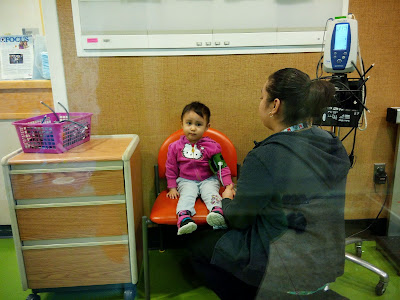I was told not to worry that her chemo is being delayed. It is very common for this to happen in this phase due to low blood counts. Some kids even get delayed for 2 to 3 weeks! Upsetting as it may sound, it is actually more unusual to be on time, whether it be a low risk, standard risk (Olivia's protocol), or high risk. It is very different from the first phase (Induction), wherein chemo continued no matter what her blood counts were.
In other news, Olivia was happy and excited to see her friends at the hospital (doctor, nurses and child life specialist). Aside from immediate family, they're the only ones she gets to physically play with nowadays. She was such a big girl and was proud of herself that she was able to get her vitals checked all by herself! Usually I would have to accompany her, but today she did it on her own!
I told the doctor our concern about her difficulty in walking. The doctor was a bit concerned too because I guess at this point, she should be walking normally again. One of the rare side effects of a chemo she was taking before is neuropathy. This can affect nerves that control muscle movement. Olivia is showing signs of a foot drop, in which she is having difficulty lifting her feet. We will be seeing a physical therapist to have her examined. We'll find out more if she will need therapy.
In moments like these, we often think of the bad things and challenges that have come our way. But we also come to realize, that these are problems with solutions. It's a difficult path to take, but we always want to look at the brighter side. We are lucky to be getting the best treatment possible for our dear Olivia. Everyday we are blessed.



if she is exhibiting footdrop it must be very painful. i hope her doctor gives her the right medication. there are some medical lit. which says that sometimes, cancer meds. can damage the nerves. if the nerves innervating her peripheral muscles are damaged then they weaken and soon atrophy. my heart goes out to her . you take care, too and i am touched by your courage.
ReplyDeletehugs to you, olivia and he Other than exercise, clinicians have other options to treat foot drop. "We're seeing a blend of the old and the new," said Dr. Moshe regarding treatment. He cited vitamin therapy, particularly B6, as helpful. Nerve medications, which are relatively new on the scene, decrease pain and improve nerve function without peripheral swelling. Topical pain medications are another new development but Dr. Moshe advised his fellow physicians to use them wisely. also this: Physical therapy and ankle-foot orthotics are two of the three main treatments for foot drop; electrical stimulation is the third. With neuromuscular electrical stimulation (NMES), the anterior tibialis muscle is directly stimulated. This helps the nerves fire, making the muscles contract. Over time, the idea is that the leg muscles will be retrained.
ReplyDeleteClinicians start using NMES while patients are in a resting position, so they can get used to it. Patients try to move their foot back and forth while the machine is cycling. They are encouraged to focus on their leg to reintegrate the brain and nerves to train the muscles to work properly again.
Later, patients walk on a flat surface as the physical therapist controls the NMES, pulling their foot upward when the muscle is stimulated and dropping it back down during the "off" portion of the cycle. Eventually, patients progress to walking on stairs, curbs etc. without the aid of the NMES. However, one downside to neuromuscular electrical stimulation is the potential for user error, as a therapist must control stimulation during the gait cycle.